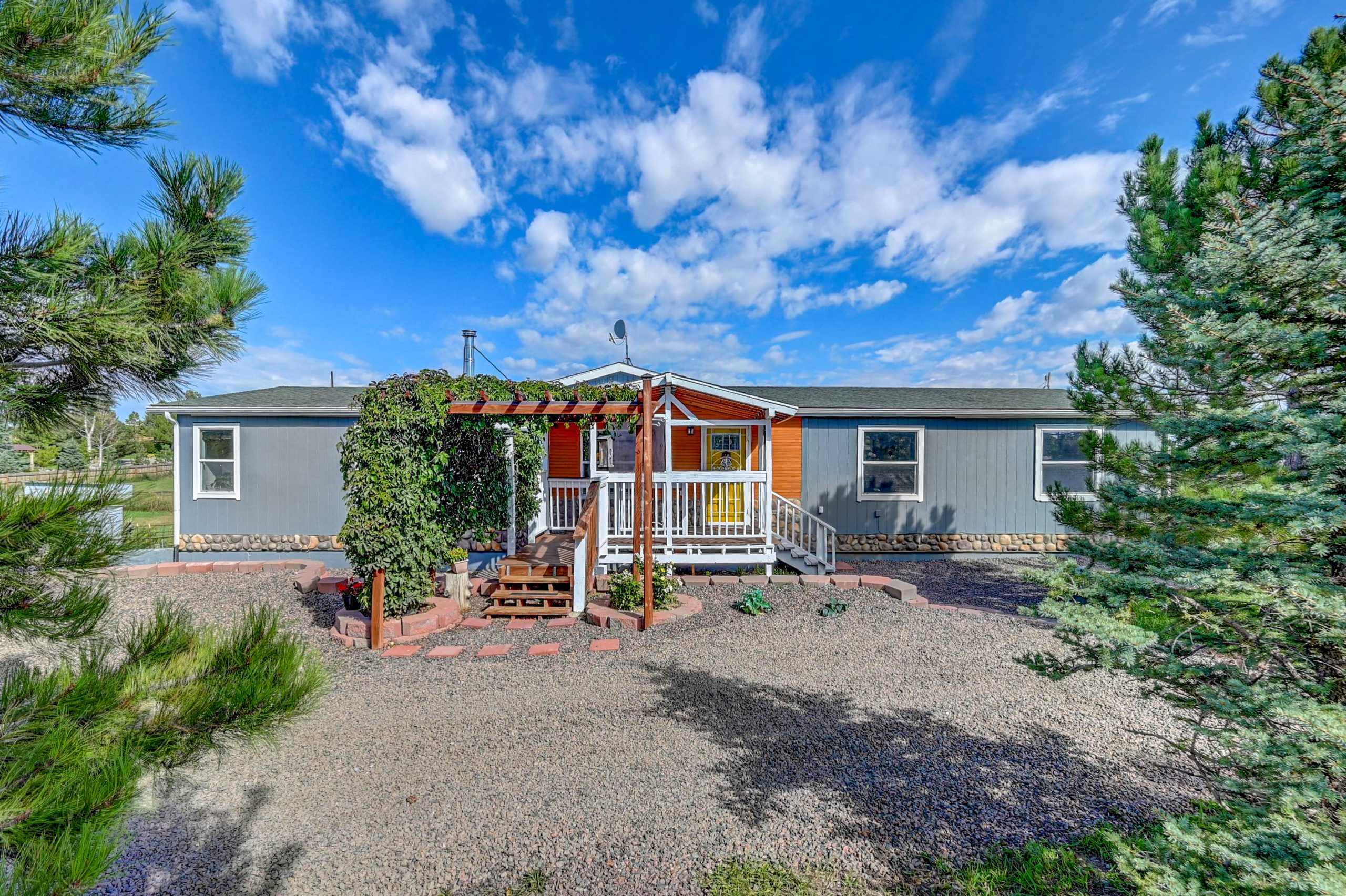Nestled in the serene landscape between Elizabeth and Kiowa, 34115 Goldenrod Circle is a manufactured home on a permanent foundation that offers rustic charm and modern comfort. This 1.8 acre horse property and 1758 square foot, 4 bedroom, 2 bathroom home creates a haven of relaxation and entertainment. The wood burning stove provides an additional economic heating source for those chilly Colorado mornings. The primary suite offers an ensuite bathroom, while the additional 3 bedrooms provide cozy retreats for family and guests. The deck extends the living space outdoors, offering an ideal spot for relaxation against the backdrop of rolling hills and endless skies. This property offers not only a home but a lifestyle. Experience small-town charm while being conveniently close to the amenities of Denver. This home is an opportunity to embrace the tranquility and beauty of Colorado. There are a variety of lending options available on this home including; USDA, FHA, VA, Conventional, and Cash. Call (970) 430-9630 to schedule a private tour or click here for more information.
What Makes a Home Modern? 6 Features of Modern Architecture

Sleek, sustainable design, open concept floor plans, minimalism, and eco-conscious thinking are defining characteristics of modern architecture. These concepts were formed in the early to mid-twentieth century as part of the modern art movement which encompassed art deco interior design and mid-century modern architecture among other styles. Here’s a breakdown of the features that define modern architecture.
6 Features of Modern Architecture
1. Clean Geometric Lines
At the heart of modernist values lies the simplification of form. Ornate decorations quickly became a thing of the past as designers became focused on taking a no-frills approach to home design. Modernist homes have a very linear feel with straight lines and exposed building materials, as opposed to more irregular shapes that were popular in the past.
2. Multifunctional Spaces
Multifunctional living spaces are a foundational element of modern homes. Built-in storage is commonly used to reflect this multi-purpose, space-saving feel. This gives added significance to the spaces in a home by upping each one’s utility. It creates an environment where everything has purpose.
3. Eco-Friendly
Modern homes are well suited for technological and eco-friendly home upgrades, as well as eco-friendly building materials and energy efficient practices, and flat roofs to accommodate solar power. A new trend is to decorate each room with plants for a calming, soothing effect. Large windows are abundant in modern architecture, allowing light to fill and expand the interior space, bringing the natural world indoors.
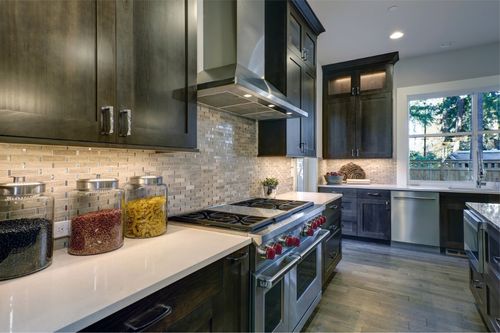
Image Source: Getty Images – Image Credit: irina88w
4. Post-and-Beam Structure
Exposed wood posts and ceiling beams are classic elements in modern architecture and modern offshoots like farmhouse interior design. Modern homes significantly emphasize the structure rather than hiding the bones behind drywall. In new modern homes the post-and-beam structure can be made of concrete, iron, or other materials. The visible horizontal and vertical beams reinforce the clean geometric lines of the space.
5. Open Concept
Modern design strives to “open” the space by eliminating enclosed rooms. A common design method is to open the kitchen and dining room into an open living space, allowing the spaces to flow into one another.
6. Minimalism
With open and connected modernist spaces, careful curation of furniture, décor, and household objects is paramount to incorporating the modernist aesthetic. Generally, modernist homes have art and furniture that reflects the clean geometric lines and the natural materials of the architecture, leaving less space for clutter. Minimalist philosophies encourage few household items that serve both form and function, which work well within this design and architectural style.
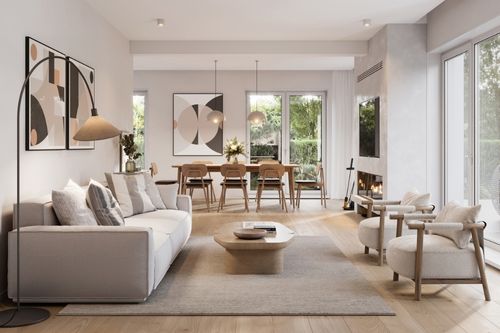
Image Source: Getty Images – Image Credit: alvarez
Contemporary vs. Modern Architecture & Design
The terms “contemporary” and “modern” are thrown around interchangeably. They do possess a certain degree of overlapping qualities, but specifically in the design world, “modern” refers to styles influenced by the early to mid-twentieth century movement, while contemporary design is what is popular in the present. Whatever interior design trends are at the forefront can be said to be contemporary, while modern interior design is still influenced by a specific period in the past.
Beautiful Berthoud Ranch Home
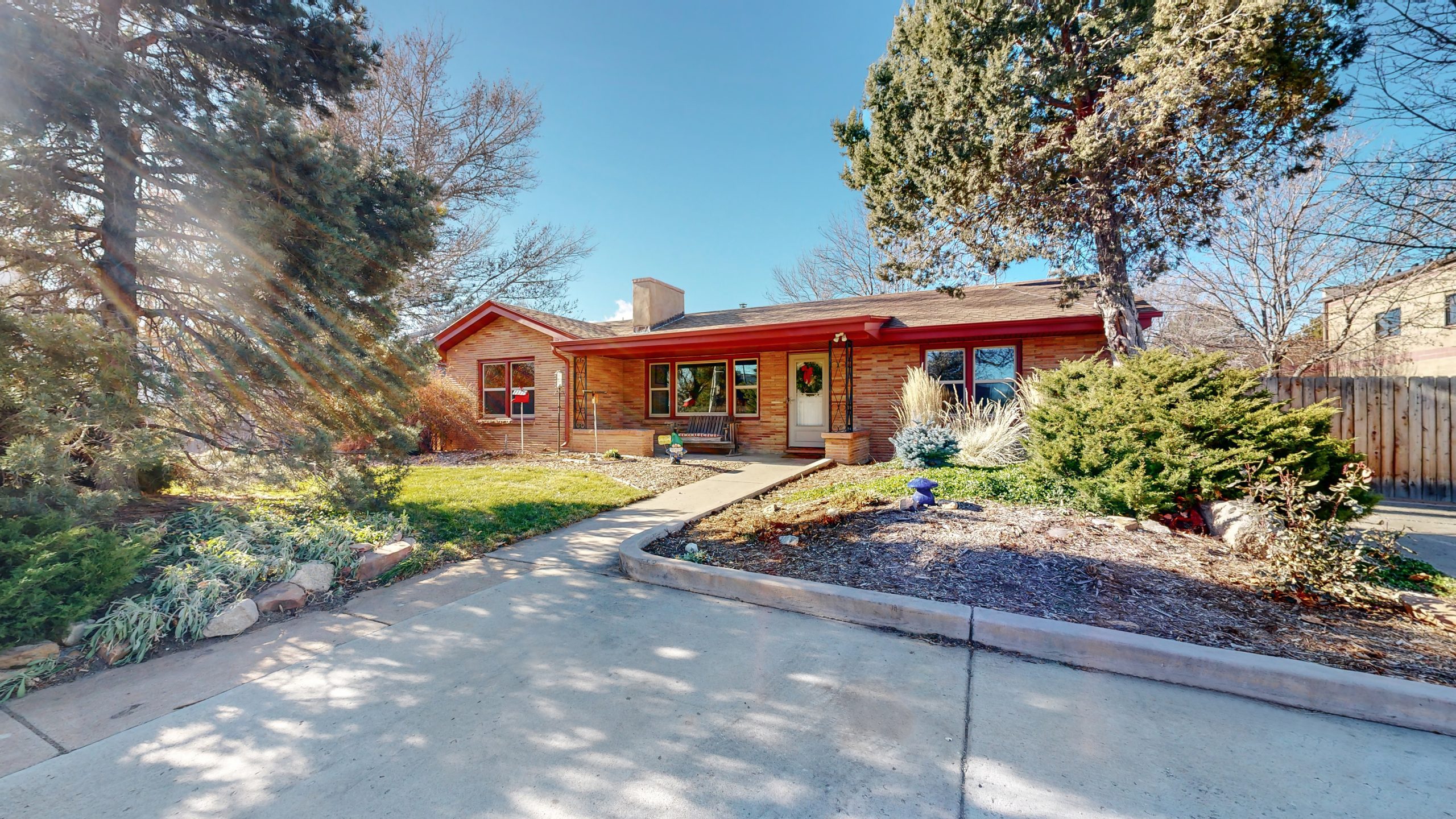
Welcome Home! 567 1st Street is a beautiful, solidly made ranch-style home in an amazing location. Cinderblock construction and Miami Stone on over 1/3 acre near downtown Berthoud. The property has Industrial zoning, which allows for many commercial uses in addition to residential. Fall in love with the fully fenced backyard resplendent with mountain views, mature landscaping, raised beds, spacious patio and hot tub. This cozy, quiet home has an eat-in kitchen with updated cabinets and countertops, both bathrooms have been updated and there is hard wood under the carpet on the main floor (except near the wood burning stove.) You will enjoy all the natural light coming into this lovely home. No HOA or metro district. Garage has 220 volt elec. service and a pellet stove so you can work in it year round. Call (970) 430-9630 to schedule a private tour or click here for more information.
Simple Garage Makeover Ideas

For some homeowners, the garage is the focal point of their home. For others, it is simply a storage space or a place to park their vehicle. Regardless of how you use your garage, these simple garage makeover ideas can help keep you organized, boost your curb appeal, and increase your home’s value.
Simple Garage Makeover Ideas
Garage Exterior
The garage door is a natural starting point for your garage makeover. A garage door replacement is a surefire way to increase the value of your home and is a common tactic for drumming up buyer interest when preparing to hit the market. But even if you don’t have the budget for a full-scale replacement, a DIY garage door makeover can still make a big difference.
Repaint Garage Exterior
Begin by prepping your garage door for a fresh coat of paint. Clean and scrub the surface with warm soapy water. Scrape off any loose paint with a putty knife or wire brush. If scraping manually is too taxing for you, use a wire wheel brush tool. Rinse and clean the door, letting it dry completely before you begin painting.
Once you’ve covered your driveway with a tarp or plastic sheeting to protect it from paint spills, you’re ready to begin painting. Choose a complimentary color for your trim to tie together your home’s exterior color scheme. Check out different styles of garage door hardware options that match the style of your home, choose your layout, and install the pieces.
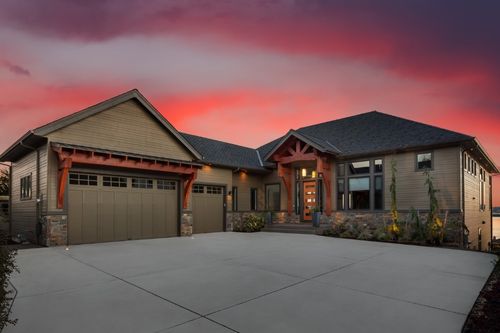
Image Source: Getty Images – Image Credit: hikesterson
Garage Interior
As you turn your attention to your garage’s interior, consider refinishing the floor first. By starting with the floor, you won’t have to continually shuffle your garage items around as you continue your makeover. If you’re considering converting your garage into a home gym, factor that in as you work on the flooring.
Start by fixing any cracks or holes with a basic patch kit. Once the surface is flat, sweep and mop from end to end. If you are removing a previous layer of paint, use a buffer to jar the old paint loose before repainting. Finishing your garage floor off with epoxy will help protect it from stains and damage. Apply two coats of epoxy twenty-four hours apart, followed by a sealing topcoat.
Organize Your Garage
In just a few steps, you can turn your garage from a cluttered oversized closet into an organized storage space. Start by taking inventory of the items in your garage. Do you have lots of tools? Is the space filled with sports equipment? Grouping like items together will keep your storage orderly. Next, decide where you would like to store your items. Overhead storage racks, rollers, and ceiling storage can significantly cut down on clutter, but these storage options are best reserved for infrequently accessed or seasonal items like holiday decorations and camping gear.
Keep frequently used items within reach. Magnetic wall panels are a great resource for your everyday tools and gardening equipment. Install shelving and drawers near your workbench to keep smaller hand tools, screws, and nails tidy and organized and add labels so you can keep track of them. If space is limited, consider a wall-mounted foldable workbench.
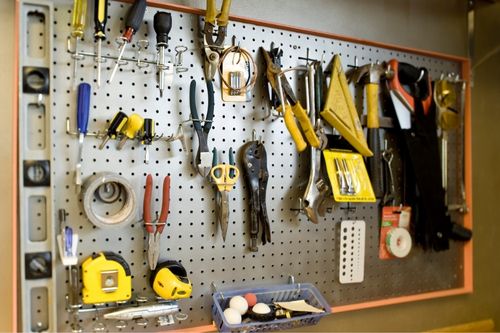
Image Source: Getty Images – Image Credit: Bluberries
Add Finishing Touches
Now it’s time to put the final touches on your garage makeover. Though installation may require the help of a professional, adding electrical outlets will pay dividends for the functionality of your garage. Installing bike hooks on the ceiling will help to save floor space and may provide just the clearance you need to park a vehicle inside. Lastly, consider upgrading your lighting. Newly installed lights will add value to your garage and make it safer.
For more simple design projects that can give your home a makeover, read the following:
5 Design Projects to Improve Your Backyard
13 Appliance Tips & Hacks for Household Chores
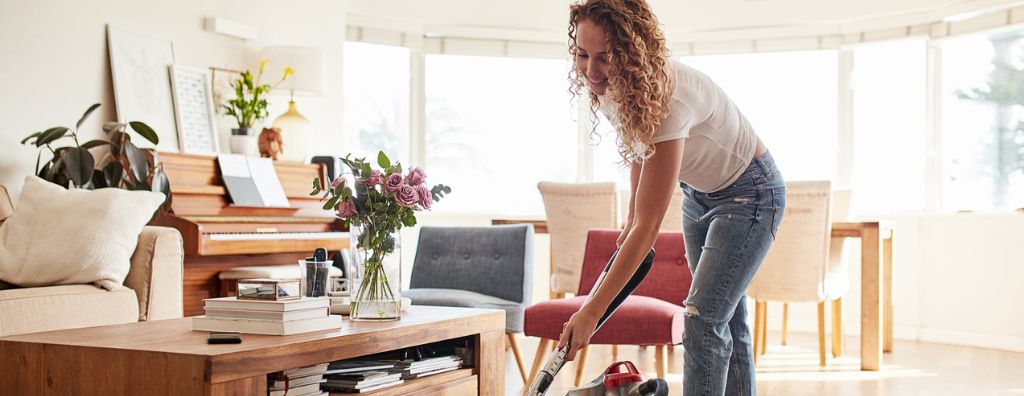
Modern home appliances make our lives so much easier. They tackle dreaded household chores, saving us time and effort. There are lots of ways to use them, however, that you may not have thought of before. Here are 13 little-known tricks for getting more than your money’s worth from your appliances.
13 Appliance Tips & Hacks for Household Chores
1. Regularly Clean Toys
Regularly clean your children’s toys. Use your dishwasher to wash teething rings, small plastic toys, mouth guards, and even baseball caps. Place items on the top rack and run the dishwasher as usual with detergent (without any dirty dishes). Put smaller items in a small mesh laundry bag so that they don’t move around.
2. Clean Ceiling Fixtures
At least once or twice a year, remove and clean your glass ceiling fixtures and light covers in an empty dishwasher. Light fixtures can be a magnet for dust and cleaning them will help your lighting shine bright in all its glory. Run the dishwasher on the normal cycle.
3. Eliminate Wrinkles
To smooth out wrinkled clothes or linens left too long in the dryer, toss a damp, lint-free cloth in with them. Run the load on the lowest setting for 10 to 15 minutes. Newer dryers also feature a steam setting that removes wrinkles and refreshes clothing between wears.
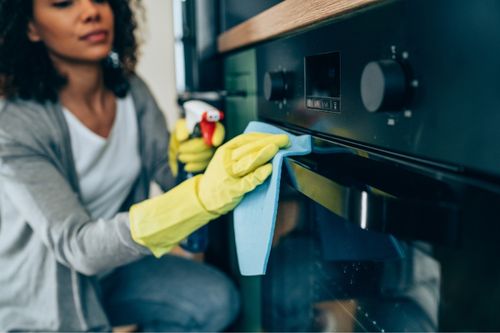
Image Source: Getty Images – Image Credit: VioletaStoimenova
4. Reduce Germs in the Kitchen
Disinfect sponges and dishcloths. Kitchen sponges and dishcloths contain billions of germs. Clean and disinfect them daily by zapping them on high in the microwave for two minutes to kill germs. Disinfecting these items periodically as opposed to throwing them away can help you cut down on waste in the kitchen.
5. Clean Upholstery
Freshen up your curtains. Vacuum heavy drapes with the upholstery attachment. Use the dusting brush attachment for lighter drapes. Wash sheer curtains in the washing machine on the delicate cycle, then hang them up while they’re damp to prevent wrinkles.
6. Remove Wax from Fabric & Carpet
To get the most out of your flooring and fabrics around your home, they require cleaning. To get rid of wax on a tablecloth, place it in your freezer until the wax is hard. Then put a flat paper bag over the wax and another under the fabric. Iron the top bag with a medium-hot iron until all the wax transfers to the bag. To remove wax from a carpet or rug, place an ice pack on the spot until the wax hardens. Shatter the wax and vacuum up the chips.
7. Clean Baseboards
Along with fans, vents, and underneath furniture, baseboards are not as frequently cleaned as other more common home surfaces but cleaning them can make a big difference in how your home feels. Dusting baseboards can be a backbreaking chore. Use your vacuum cleaner and the dusting brush attachment to avoid having to bend down. Do the same to clean chair and table legs.
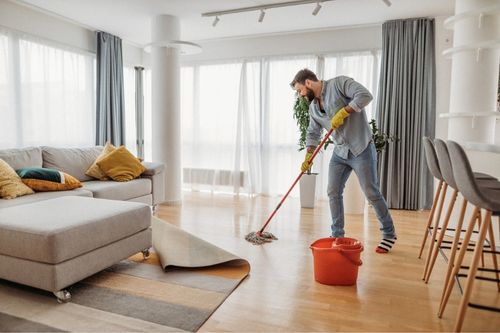
Image Source: Getty Images – Image Credit: milan2099
8. Organize Your Refrigerator
Use the built-in features of your refrigerator to organize food by category. Designate certain shelves or areas for leftovers, preferably front and center, so you don’t forget they’re in there. Use special-purpose bins for their intended use: crispers for vegetables, deli trays for deli meats and cheeses, cold storage trays for meats. Newer models also feature convertible cooling zones to keep food fresh.
9. Dust Blinds
Extend the blinds fully and turn the slats to the closed position. Use the dusting brush attachment on your vacuum cleaner to clean the slats from top to bottom. Then open and re-close the slats in the opposite direction and repeat the process.
10. Clean Your Microwave & Range
The best time to clean your microwave is immediately after using it. Thanks to residual steam, all you have to do is wipe it out with a paper towel or damp sponge. To clean old messes, microwave two cups of water on high for five minutes. The steam will soften cooked-on spills, which you can wipe off with a paper towel or cloth. Your gas/electric range needs regular cleaning as well, especially if you use it frequently.

Image Source: Getty Images – Image Credit: PeopleImages
11. Exterminate Dust Mites
Dust mites live off human and animal dander and other household dust particles and can lower your home’s air quality. They thrive in sofas, carpets, and bedding. Use the upholstery attachment to vacuum your mattress and upholstered furniture regularly to minimize dust mites. Be sure to empty the canister in an outdoor trashcan.
12. Groom Your Pet
After you’ve groomed your dog or cat, use the dusting brush attachment to clean up after. It’s an easy way to collect shedding fur, especially from carpeted areas or upholstery.
13. Remove Grime in Shower
Wash plastic shower curtain liners in the washing machine with hot water and detergent on the regular cycle. Throw in a small bath towel to help “scrub” mildew and soap scum off the liner. Then rehang the liner and let it air-dry. Regularly clean your bathtub and light candles to keep your bathroom smelling fresh.
For more information on home appliances, protecting your home from damage, and more, head to the Living section of our blog:
How to Save Money to Buy a House
It’s no secret that buying a home is a serious financial undertaking, but aspiring homeowners are often left wondering what the methods behind the process actually look like. One of the telltale signs that you’re ready to buy a home is having substantial savings to use toward the purchase. The following information goes under the hood of the buying process to explain how much you need to save and some useful methods of saving money.
Making a Down Payment on a Home
The down payment is a large payment made by the buyer upfront to help fund the purchase of a home. Although a down payment of 20 percent of the home’s purchase price will avoid the need to purchase private mortgage insurance (PMI), down payments of this size are not the norm. According to the National Association of REALTORS®, in 2021, the typical down payment was seven percent for first-time home buyers and 17 percent for repeat buyers (NAR)1.
So, how long does it take to save up for the down payment? The answer is unique to each buyer. It depends on your needs as a homeowner, whether you have a deadline, and what you’re able to afford. Your mortgage will factor into the equation, too. Different mortgage types have different down payment requirements, with certain loan products requiring as little as 3% down to qualify. Remember that in general, a higher down payment equates to a lower interest rate and lower monthly payments for your mortgage.
To get an idea of what’s affordable, use our free Home Monthly Payment Calculator by clicking the button below. With current rates based on national averages and customizable mortgage terms, you can experiment with different down payment amounts to get estimates of your monthly payment for any listing price.

Image Source: Getty Images – Image Credit: damircudic
How to Save Money to Buy a House
No matter where your savings stand, these strategies can help to beef up your savings account as you prepare to buy a home.
- Reduce Debt: Carrying extra debt can weigh you down throughout the home buying process. And even if you make progress on your savings, you’ll be stuck in limbo if you’re not able to qualify for a mortgage. Consider refinancing existing loans and explore ways to reduce credit card debt to set yourself up for success. This will also put you in a better position when you enter the pre-approval process for your mortgage.
- Rethink Your Budget: Are your streaming subscriptions piling up? Is now the best time for that five-star vacation you had planned? Saving up to buy a home doesn’t mean you need to abandon all your leisurely expenses, but it is worth it to look at them from a new perspective to find ways you can save. It’s also a good time to examine your bills and self-audit your current living expenses.
- Increase Your Savings: Once you go through your expenditures with a fine-toothed comb, you may find there’s ample opportunity to increase your savings. Regularly contributing to a high-yield savings account will put you on the fast track to pile up your extra funds and ensure that you’re setting them aside.
- Additional Streams of Income: If you’ve ever thought of using your unique skills to generate some extra dollars, now is the time to act. Whether it’s teaching music lessons, offering tutoring classes, selling your handmade goodies at the local farmer’s market, etc., the extra revenue from a side hustle can help you purchase a home.
Budget for Additional Home Purchase Costs
Once you’ve got your head wrapped around the down payment and formed your saving strategy, you can shift your financial preparations toward the remaining costs of buying a home. Here are a few to keep in mind:
- Closing Costs: Closing costs for buyers typically range anywhere between 2% and 6% of the home loan amount but vary by transaction.
- Homeowners Insurance: Lenders will usually require that your purchase a homeowners insurance policy, which covers your home, your belongings, injury or property damage to others, and living expenses if you are unable to live in your home temporarily because of an insured disaster.
- Repairs and Remodeling: The home you end up buying may very well be in need of repair, and you may have certain remodeling projects in mind. These costs can stack up quickly, so be sure to carve out ample room in your home buying budget accordingly.
- Homeowners Association (HOA) Fees: If the home you’re purchasing is governed by a Homeowners Association (HOA), you will be required to pay monthly HOA fees on top of your existing mortgage monthly payment.
For more information on preparing to buy a house, visit our Guide to Buying a Home:
How to Price Your Home for Sale

It’s natural for sellers to want to get every step of the selling process right, but a successful home sale depends on an accurate listing price. Your agent will work closely with you to set the price, but in the meantime, you can use the following information to better understand what goes into this process.
- Understanding the Value of Your Home: Market Value vs. Assessed Value and More
- The Difference Between a Comparative Market Analysis and an Appraisal
What’s your home worth?
Nothing can replace the professional knowledge and local expertise of a real estate agent, but automated valuation models (AVMs) can be a helpful first step in determining what your home is worth. Like comps, AVMs assess your home by comparing its information with the listings in your area. Windermere’s Home Worth Calculator evaluates your property and the surrounding market to give you an idea of how much it’s worth. Try it here:
What factors influence home prices?
Understanding what factors influence home prices will give you a deeper knowledge of the market, give clarity to the selling process, and help you work with your agent to accurately price your home.
Comparable Home Sales
Comparable home sales—or “comps”—have a major impact on the price of your home. Comps refer to the comparable homes in your area, both pending and sold, within the last six months. Your Windermere agent can provide you with a Comparative Market Analysis (CMA) to better determine the price of your home. CMAs factor in aspects such as square footage, age, and lot size compared to other homes in your area, to determine how your home should be priced among the competition.
Your Home’s Location
Naturally, your home’s location plays a significant role in its asking price. Depending on the market conditions in your area, whether you reside in a metropolitan, suburban, or rural location, and the home’s proximity to amenities, schools, and entertainment all contribute to the price.

Image Source: Getty Images – Image Credit: VioletaStoimenova
Your Home’s Condition
If you have recently invested in upgrades or other remodeling projects for your home, they could increase your asking price. However, the price increase potential depends on the kind of renovation, its ROI, and how valuable it is to buyers in your area. If the home needs repair, it will likely generate less interest from buyers than better maintained homes at your price point. Any outstanding repairs or projects looming overhead will make the home less attractive to buyers and could lead to a low appraisal.
Seasonality
Any factors that impact market supply and demand are worth taking into consideration when preparing to price your home, and seasonality is one that cannot be overlooked. Typically, market activity slows in the winter and picks up during the spring and summer months. However, market seasonality varies region to region. Talk to your Windermere agent about the seasonality trends in your area and how they factor into your asking price.
Market Conditions
Naturally, all sellers want to price their home competitively, but what a competitive price looks like depends on the market conditions, such as whether it’s a buyer’s or seller’s market. Some sellers think that pricing their home over market value means they’ll sell for more money, but the opposite can often be true. Overpricing your home presents various dangers such as sitting on the market too long, which can result in selling for well below what it’s worth.
Periodic Price Adjustments
Pricing a home isn’t a set-it-and-forget-it proposal. As with any strategy, you need to be prepared to adapt to fast-changing market conditions, new competition, a lack of offers, and other outside factors.
These are the basic tenets for understanding what goes into the price of a home. When you’re ready, a Windermere agent will interpret and expand on this information, perform a CMA for your home, and guide you throughout your selling journey.
What Is an Adjustable-Rate Mortgage (ARM)?

An integral part of the formula to successfully buying a home is securing the correct amount of financing. Once you’ve found the home you’d like to pursue, one of your primary tasks is exploring different loan products to see which best fits your situation. Eventually, you’ll come to a fork in the road where you’ll need to decide between a fixed-rate mortgage and an adjustable-rate mortgage (ARM). The following information will help you gain a better understanding of ARMs to help you decide whether they’re right for you.
What Is an Adjustable-Rate Mortgage (ARM)?
After your down payment, your mortgage will finance the remainder of your home purchase. Whereas fixed-rate mortgages allow you to lock in a specific interest rate and payment for the life of your loan, adjustable-rate mortgages’ interest rates will fluctuate over time, thus changing your loan payment. It’s typical for ARMs to begin with a low introductory interest rate, but once that first stage of the loan has passed, they will begin to shift up and down. ARMs generally have a cap that specifies the maximum rate that can occur for that loan.
Let’s say you secure an adjustable-rate mortgage with 30-year terms, the first five of which are at a fixed rate. When the variable interest portion of the loan kicks in, your mortgage’s fluctuations will be measured against an index. If the index is higher than when you secured the loan, your rate and loan payment will go up—and vice versa. How often your ARM rates change depends on your agreement with your lender. Talk to your mortgage broker to learn more about the characteristics of adjustable-rate mortgages.

Image Source: Getty Images – Image Credit: FG Trade
Different Types of Adjustable-Rate Mortgages (ARMs)
Payment-Option ARM: You’ll have flexibility to choose your monthly payments with a payment-option ARM, including interest-only payments and minimum payments that don’t cover interest. These loan products can get home buyers into hot water quickly when rates increase.
Interest-Only ARM: With an interest-only ARM, you pay just the interest on the loan for a specified introductory period, then the principal payments kick in on top. The longer the introductory period, the higher your payments will be when the delayed principal payments enter the equation.
Hybrid ARM: As outlined above, a hybrid ARM begins with a fixed-rate introductory period followed by an adjustable-rate period. Typically, a hybrid ARM’s fixed-rate period lasts anywhere between three to 10 years, and its rates adjust at an agreed-upon frequency during the adjustable-rate period, such as once every six months or once a year.
Pros and Cons of an Adjustable-Rate Mortgage (ARM)
| Pros | Cons |
|
|
|
|
|
|
Home Monthly Payment Calculator
To get an idea of how your mortgage payment will fit into your budget, use our free Home Monthly Payment Calculator by clicking the button below. With current rates based on national averages and customizable mortgage terms, you can experiment with different values to get an estimate of your monthly payment for any listing price.
For more information on financing your next home purchase, connect with an experienced, local Windermere agent.
How to Handle Asbestos in Your Home
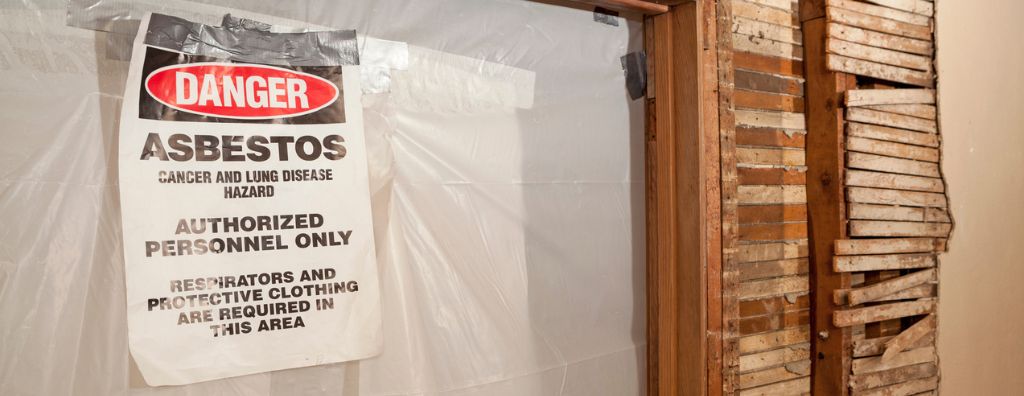
Throughout the mid twentieth century, asbestos was commonly used throughout the homebuilding process. It was typically used as insulation, but would also pop up in vinyl flooring, cement siding, walls, pipes—you name it. After it was discovered that inhaling asbestos fibers has serious health effects, its domestic production slowed, and legislation was put forth to ban it altogether.
However, just like lead paint, homes that were built in the asbestos era still carry a dormant risk. If your home contains asbestos, you should be aware of its dangers, how to handle it, and how to go about removing it safely.
How to Handle Asbestos in Your Home
Having asbestos material in your home is not inherently hazardous if the material is left undisturbed. So, if your asbestos material is intact and in good condition, the best thing to do is to leave it be. However, the moment asbestos material becomes damaged—either from degrading over time or because of a sudden accident—it becomes dangerous. Once asbestos fibers are released, it can spell trouble for you and your household.
Testing for Asbestos
If you find damaged asbestos material, you should cordon off the area to the best of your ability to limit exposure. If restricting the area means you could disturb the asbestos, then it’s best to refrain from interacting with it and let a professional handle it.
DIY asbestos testing is possible, but it can be highly toxic if you don’t take the proper precautions. An asbestos inspector will conduct a thorough examination of your home to determine the extent of its presence and provide their recommended course of action. It is advised to test for asbestos before making an addition or a large-scale remodel to your home.
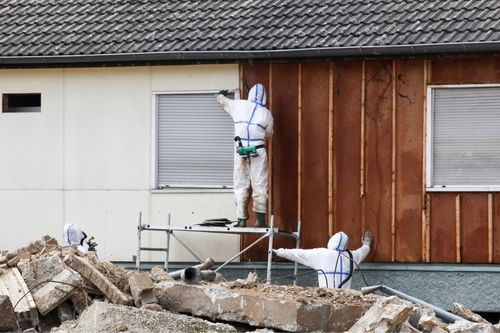
Image Source: Getty Images – Image Credit: ricochet64
Removing Asbestos
You can either repair existing asbestos exposure or have it removed. Repairs can be cheaper in the short term but may simply be prolonging the inevitable. Making repairs on your own is generally not recommended, since the slightest mishandling of the exposed asbestos can create a much bigger problem.
When it comes to removing asbestos, you’ll want to enlist the help of a professional. As with any contractor, ask for quotes and make comparisons before deciding who you’ll hire. Before the job is finalized, have your home tested to ensure that all asbestos has been safely removed from the premises.
For more tips on home safety, home maintenance, and avoiding dangers caused by the systems in your home, read our blog post on How to Prevent and Deal with Mold.
Featured Image Source: Getty Images – Image Credit: BanksPhotos
7 Tips for Staging Your Home Yourself

Nowadays, home staging is an integral part of the home selling process. The impact of home staging is crystal clear, but how you go about it deserves some consideration. Many homeowners will hire a home staging professional, trusting their expertise to make their home as appealing as possible to buyers. However, if hiring a professional isn’t in your budget, taking a DIY approach to home staging can deliver its own benefits.
7 Tips for Staging Your Home Yourself
1. Declutter
The first rule of home staging: make it tidy! A well-staged home should make potential buyers feel comfortable and at ease. To make that happen, it’s important that the spaces in your home are free of clutter. Consider investing in storage bins or a separate storage space temporarily to pare down the items in your home as much as possible.
2. Deep Clean
To really make your home sparkle, it will need more than a cursory cleaning. On top of your usual cleaning routine, get those hard-to-reach and uncommon spots throughout your home that will make it feel spotless. Putting some elbow grease into your bathroom surfaces, underneath and behind furniture, baseboards, and all switches and handles will make a difference when guests enter your home.
3. Fresh Paint
Not only does adding a coat of fresh paint do wonders for the look of your home, it’s a low-cost, high-ROI investment for a DIY project as important as home staging. Going for neutral colors will help to create balance in your interior while appealing to a wide spectrum of buyers’ tastes. It’s the splashes of color on top of a neutral foundation that will help guide visitors’ eyes from room to room.
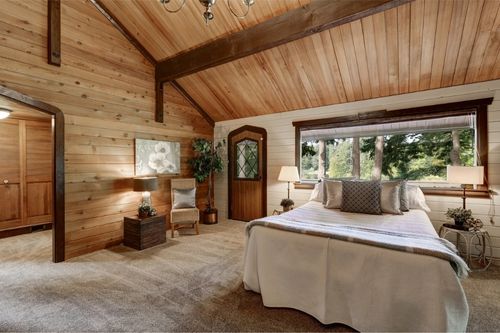
Image Source: Getty Images – Image Credit: irina88w
4. Curb Appeal
You only get once chance to make a first impression on potential buyers visiting your home and upping your curb appeal will give you the best chance of wowing them. Take a trip to your local hardware store and prepare to spend some time working in the front yard. Projects that improve the look and quality of your lawn, flower beds, walkways, outdoor lighting, windows, and trim will impress buyers and can increase the value of your home.
5. De-Personalize
Once a buyer pulls up to your property, you want to give them every opportunity to imagine themselves in the home. That’s why it’s important to de-personalize your interior and let them fill it with their own imagination. Remove all family photos, notes, personal gifts, and the like from your home. Aim for a décor style that’s not too ornate and not too bland—think calm, simple, and clean.
6. Focus on Accents
Once you’ve applied fresh paint, boosted your curb appeal, and de-personalized your home, you’re ready to add décor accents. Again, the most important thing is that buyers feel comfortable in your home, so your accents should reflect that notion. Add area rugs that are inviting but not too loud, keep freshly folded towels in the bathroom, and consider adding house plants throughout your spaces to make them feel natural.
7. Design Hacks
A few key design hacks will help you round out your DIY home staging project. If you’re struggling with making the smaller spaces in your home feel comfortable, try adding a mirror. Mirrors help to reflect light and can help narrow or cramped spaces feel bigger. Arrange your living room furniture in a way that emphasizes the room’s dimensions. Since you’re designing your home with open houses in mind, the TV no longer needs to be the focal point of the living room.
For more information on preparing to sell your home, helpful tips on working with an agent, moving checklists, and more, visit our Seller Essentials Home Selling Guide.
Featured Image Source: Getty Images – Image Credit: PC Photography
 Facebook
Facebook
 X
X
 Pinterest
Pinterest
 Copy Link
Copy Link
